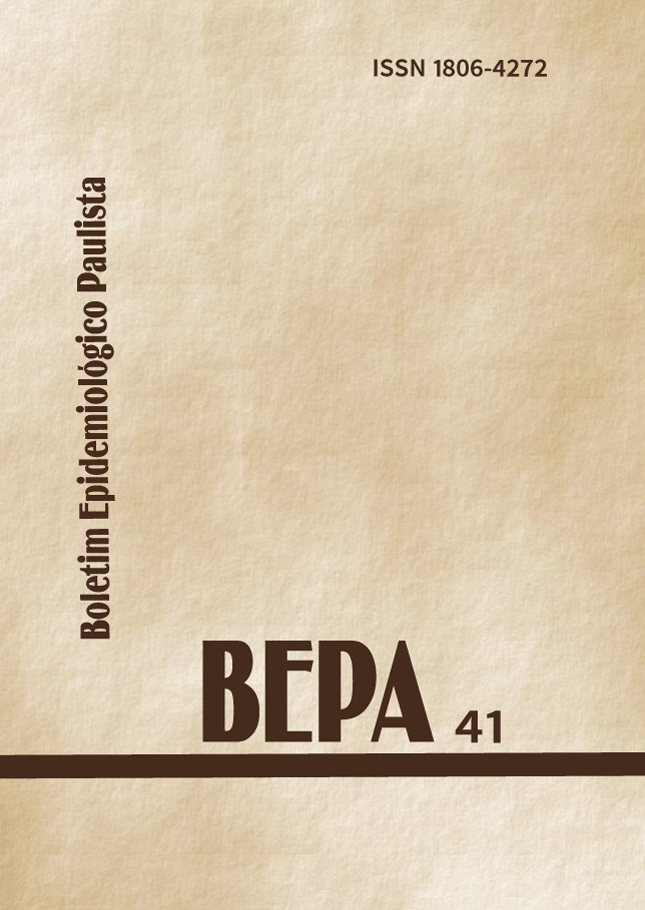Resumo
O diagnóstico laboratorial ante-mortem da raiva humana envolve a pesquisa do vírus em folículo piloso, saliva, líquido cefalorraquidiano (LCR) e impressões de córnea, e a pesquisa de anticorpos neutralizantes do vírus da raiva (AcN) em amostras de soro e LCR. A presença de AcN no soro ou LCR de indivíduos não vacinados é indicativa de raiva, porém, esses resultados só ocorrem nos estágios finais da doença. Neste estudo foram analisados os resultados da pesquisa de AcN em amostras de soro e/ou LCR de três pacientes com suspeita de raiva, sem histórico de sorovacinação. O método de pesquisa de AcN foi o microteste simplificado de inibição de fluorescência. O paciente A, apesar de não ter tido análise de sistema nervoso central (SNC), teve diagnóstico de raiva com base nos sintomas clínicos e títulos de AcN de 3,0 UI/mL no soro e 0,37 UI/mL no LCR. Dos dois pacientes que tiveram o vírus identificado post-mortem no SNC, o paciente B apresentou LCR com título de 12,0 UI/mL de AcN e o paciente C apresentou resultados negativos de AcN no soro e no LCR, sendo compatíveis com a relação existente entre coleta e período de morbidade. Esses resultados mostram que a pesquisa de AcN de pacientes suspeitos de raiva, sem histórico de sorovacinação e com longo período de morbidade, deve ser feita em coletas subseqüentes de soro e LCR, para possibilitar o diagnóstico ante-mortem da raiva, especialmente quando a coleta post-mortem de SNC tornar-se inviável.
Referências
CDC. Centers for Disease Control and Prevention. Human Rabies Prevention – United States, 1999. Recommendations of the Advisory Committee on Immunization Practices (ACIP). MMWR 1999 jan 8; 48 (RR-1): 1-21.
Constantine DG. Rabies transmission by no byte route. Public Health Rep. 1962, 77:287-289.
CDC. Centers for Disease Control and Prevention. Investigation of rabies infections in organ donor and transplant recipients-Alabama, Arkansas, Oklahoma, and Texas, 2004. MMWR 2004 jul 9; 53(26):586- 589.
Bronnert J, Wilde H, Tepsumethanon V, Lumlertdacha B, Hemachudha T. Organ Transplantations and Rabies Transmission. J Travel Med. 2007; 14(3):177–180.
WHO. World Health Organization. Rabies. Disponível em: http:/www.who.int/mediacentre/factsheets/ fs099 [2006 dezembro 22].
MS. Ministério da Saúde. Dados sobre a raiva. Disponível em: http://portal.saude.gov.br/portal/arquivos/ pdf/raiva_2006.pdf [2007 abril 08].
WHO. World Health Organization. Intra-vitam diagnosis. Disponível em: http://www.who.int/rabies/human/ intra_vitam/en/print.html [2007 maio 07].
Murphy FA. Rabies Pathogenesis. Arch Virol. 1977; 54:279-297.
Hattwick MAW, Gregg MB. The disease in man. In: Baer GM. ed. The Natural History of Rabies 1975; Vol II: p.281-305.
WHO. World Health Organization. Expert Committee on Rabies. Eighth report. WHO Technical Report Series; 824. Geneva 1992.
Warrell MJ, Warrell DA. Rabies and other lyssavirus diseases. The Lancet 2004 mar 20; 363:959-969.
Crepin P, Audry L, Rotyvel Y, Gacoin A, Carroff C, Bourhy H. Intravitam diagnosis of human rabies by PCR using saliva and cerebrospinal fluid. J Clin Microbiol. 1998; 36(4):1117-1121 ::
Dean DJ, Abelseth MK, Atanasiu P. The fluorescent antibody test In: Meslin FX, Kaplan MM, Koprowsky H. Laboratory techniques in rabies 1996. Genebra: World Health Organization; p. 88-95.
Koprowsky H. The mouse inoculation test. In: Meslin FX, Kaplan MM, Koprowsky H. Laboratory techniques in rabies 1996. Genebra: World Health Organization; p. 80-87.
Favoretto SR, Carrieri ML, Tino MS, Zanetti. CR, Pereira OAC. Simplified fluorescence inhibition microtest for the detection of rabies neutralizing antibodies. Rev Inst Med trop S Paulo 1993; 35:171- 175.
Rupprecht CE. Rhabdoviruses: Rabies Virus. In: Baron S, Peake RC, James DA, Susman M, Kennedy CA, Singleton MJD, Schuenke S. Medical Microbiology. Fourth Edition. The University of Texas Medical Branch at Galveston, 1996. Disponível em: http://www.ncbi.nlm.nih.gov/books. [2007 maio]
Rupprecht CE, Hanlon CA, Hemachudha T. Rabies re-examined. The Lancet Infec Dis 2002 June 2; 327-343. Disponível em: http://infection.thelancet.com
CDC. Centers for Disease Control and Prevention. Rabies in a laboratory worker – New York. MMWR 1977; 26:183-184.
Hattwick MA, Weis TT, Stechschulte CJ, Baer GM, Gregg MB. Recovery from rabies. A case report. Ann Intern Med. 1972; 76:931-942.
Porras C, Barboza JJ, Fuenzalida E, Adaros HL, Oviedo AM, Furst J. Recovery from rabies in man. Ann Intern Med. 1976; 85: 44-48.
Alvarez L, Fajardo R, Lopez E, Pedroza R, Hemachudha T, Kamolvarin N, Cortes G, Baer GM. Partial recovery from rabies in a nine-year-old boy. Pediatr Infect Dis J. 1994; 13:1154-1155.
Madhusudana SN, Nagaraj D, Uday M, Ratnavalli E, Kumar MV. Partial recovery from rabies in a six-yearold girl. Int J Infect Dis. 2002; 6:85-86.
CDC. Centers for Disease Control and Prevention. Recovery of a Patient from Clinical Rabies - Wisconsin, 2004. MMWR 2004; 53 (50):1171-1173.
]24. CDC. Centers for Disease Control and Prevention. Imported human Rabies- France, 1992. MMWR 1992 december; 41(51):953-955.
CDC. Centers for Disease Control and Prevention. Human Rabies – Tennessee, 2002. MMWR 2002 september 20; 51(37):828-829.
Hemachudha T, Wacharapluesadee S. Antemortem diagnosis of human rabies. Clin Infect Dis. 2004; 39:1085-1086.

Este trabalho está licenciado sob uma licença Creative Commons Attribution 4.0 International License.
Copyright (c) 2007 Luciana Botelho Chaves, Andréa de Cássia Rodrigues Silva, Graciane Maria Medeiros Caporale, Karin Corrêa Scheffer, Salim Jorge Waquim Neto, Maria Luiza Carrieri, Ivanete Kotait
